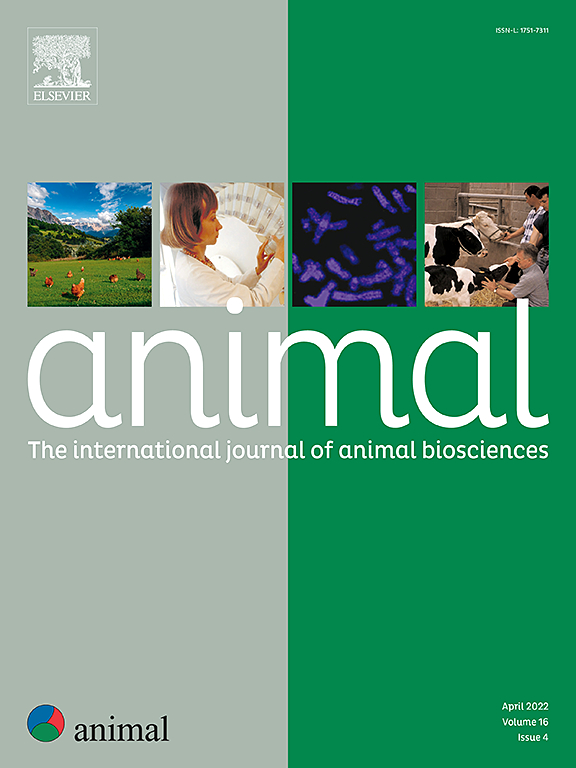Application of milk mid-infrared spectroscopy for prediction of energy balance and associated traits in Fleckvieh and Holstein Friesian dairy cows
IF 4.2
2区 农林科学
Q1 AGRICULTURE, DAIRY & ANIMAL SCIENCE
引用次数: 0
Abstract
A negative energy balance in early lactation increases the susceptibility of dairy cows to metabolic and infectious diseases. Energy balance (EB) is therefore a valuable trait in both herd management and breeding strategies, to improve the health and efficiency of dairy cows. However, routine on-farm recording of energy intake is hardly feasible, necessitating suitable alternatives to determine EB or related traits. A potential alternative is prediction based on mid-infrared (MIR) spectral and test-day data from routine milk recording. Thus, the aim of the present study was to develop spectrometric prediction equations for EB and related traits, i.e., energy intake (EI) and dry matter intake (DMI), for Fleckvieh and Holstein Friesian dairy cows. A dataset was available comprising 64 988 daily observations of phenotypes including test-day variables and milk MIR spectra from 18 Fleckvieh and 71 Holstein Friesian cows, collected on a research farm between 2014 and 2021. Based on this dataset, quantitative prediction models were developed using different combinations of 212 selected first derivative MIR spectra and test-day variables by applying partial least squares regression analysis. An additional dataset was used for external validation by farm of the developed prediction equations, comprising 1 971 records on 16 Fleckvieh and 20 Holstein Friesian cows collected between 2017 and 2020 on another research farm. In addition to different validation scenarios, various effects, including breed, parity, and concentrate intake, were also evaluated for their impact on predictability of the traits considered. In general, prediction equations have shown to be most accurate when they included 212 MIR spectra along with parity and milk yield as predictors. The prediction equations provided moderate accuracies exhibiting correlation coefficients of 0.59 to 0.75 for EB, 0.63 to 0.71 for DMI, and 0.69 to 0.71 for EI, depending on the specific validation scenarios. The effects of breed, parity, and concentrate level showed differing impacts on the predictive capacity of the models for EB, DMI, and EI, with variations across traits. The results demonstrate potential for the generation of population-level phenotypes for EB, DMI, and EI based on routinely available MIR spectra and test-day variables. This approach would facilitate the routine recording of such indicators on a large scale for farm management and inclusion in genetic evaluation systems.
乳中红外光谱在预测弗立科奶牛和荷斯坦奶牛能量平衡及相关性状中的应用
泌乳早期的负能量平衡增加了奶牛对代谢和传染病的易感性。因此,能量平衡(EB)在奶牛群管理和育种策略中都是一个有价值的性状,可以改善奶牛的健康和效率。然而,常规的农场能量摄入记录几乎是不可行的,需要合适的替代方法来确定EB或相关性状。一种潜在的替代方法是基于中红外光谱和常规牛奶记录的测试日数据进行预测。因此,本研究旨在建立Fleckvieh和Holstein Friesian奶牛EB及其相关性状(能量采食量(EI)和干物质采食量(DMI))的光谱预测方程。可获得的数据集包括2014年至2021年期间在一个研究农场收集的18头弗莱克维和71头荷斯坦弗里西亚奶牛的64 988例日常表型观察,包括测试日变量和牛奶MIR光谱。在此基础上,采用偏最小二乘回归分析方法,选取212个一阶导数MIR光谱与试验日变量的不同组合,建立定量预测模型。另一个数据集用于由农场对开发的预测方程进行外部验证,该数据集包括2017年至2020年在另一个研究农场收集的16头弗莱克维和20头荷斯坦弗里西亚奶牛的1971条记录。除了不同的验证场景,还评估了各种影响,包括品种、胎次和精料摄入量,对所考虑性状的可预测性的影响。一般来说,当预测方程包括212 MIR光谱以及宇称和产奶量作为预测因子时,预测方程是最准确的。根据具体的验证场景,预测方程具有中等精度,EB的相关系数为0.59 ~ 0.75,DMI的相关系数为0.63 ~ 0.71,EI的相关系数为0.69 ~ 0.71。品种、胎次和集中程度对EB、DMI和EI模型的预测能力有不同的影响,且各性状之间存在差异。结果表明,基于常规可用的MIR光谱和测试日变量,EB、DMI和EI有可能产生群体水平的表型。这一方法将有助于对这些指标进行大规模的常规记录,以供农场管理和纳入遗传评价系统。
本文章由计算机程序翻译,如有差异,请以英文原文为准。
求助全文
约1分钟内获得全文
求助全文
来源期刊

Animal
农林科学-奶制品与动物科学
CiteScore
7.50
自引率
2.80%
发文量
246
审稿时长
3 months
期刊介绍:
Editorial board
animal attracts the best research in animal biology and animal systems from across the spectrum of the agricultural, biomedical, and environmental sciences. It is the central element in an exciting collaboration between the British Society of Animal Science (BSAS), Institut National de la Recherche Agronomique (INRA) and the European Federation of Animal Science (EAAP) and represents a merging of three scientific journals: Animal Science; Animal Research; Reproduction, Nutrition, Development. animal publishes original cutting-edge research, ''hot'' topics and horizon-scanning reviews on animal-related aspects of the life sciences at the molecular, cellular, organ, whole animal and production system levels. The main subject areas include: breeding and genetics; nutrition; physiology and functional biology of systems; behaviour, health and welfare; farming systems, environmental impact and climate change; product quality, human health and well-being. Animal models and papers dealing with the integration of research between these topics and their impact on the environment and people are particularly welcome.
 求助内容:
求助内容: 应助结果提醒方式:
应助结果提醒方式:


